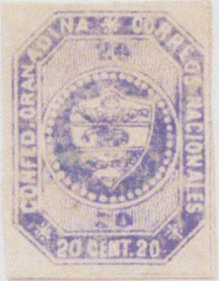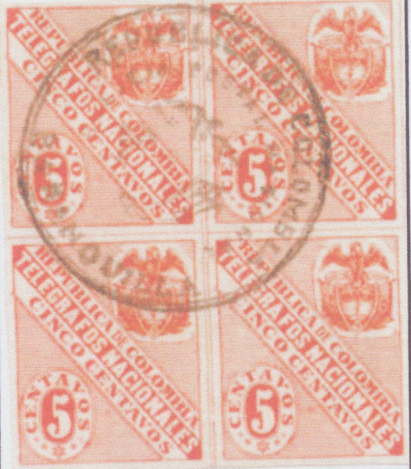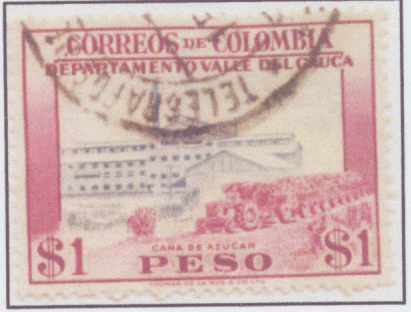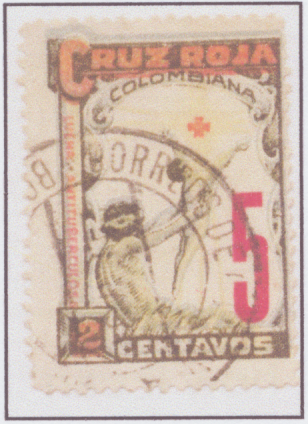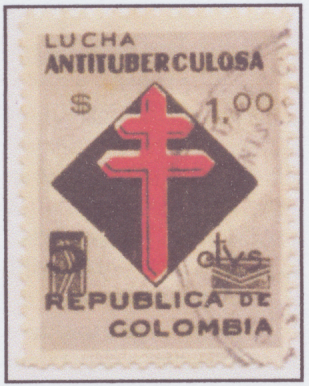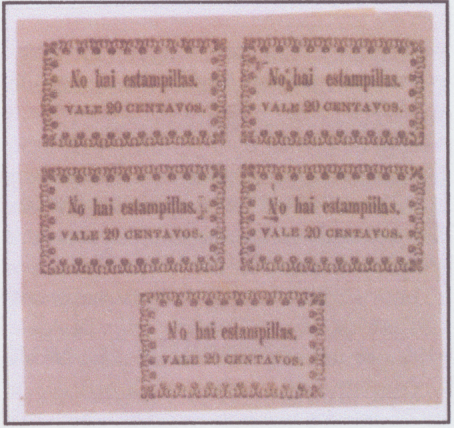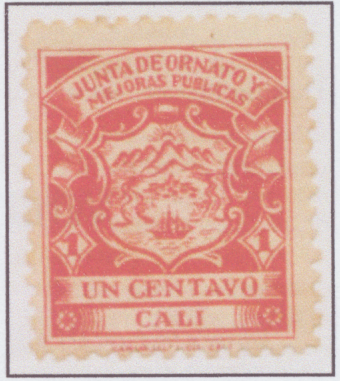
The Many Facets of Colombian Philately, from Philip IV to office clippingsBy Alan D Anyon FRPSL
The postal laws of Colombia made it clear that when supplies of national postage stamps were unavailable, such as in times of war, the local postmaster should write on mail No Hay Estampilas (there are no stamps), the amount of postage collected and sign the declaration. Despite this instruction a number of postmasters had their own local labels prepared. The first was San Luís in 1863. However in 1879 the Cali postmaster produced small labels of 6 values, printed on 4 different papers with 4 separate printings and in sheetlets of 5 placeable stamps so a full “collection” would comprise 480 stamps. A complete sheetlet of the 20c printed on blue paper Plate I is in Fig 9. An even more flagrant example of disregarding regulations was in Barbacoas in 1902-03 during the War of 1,000 Days. So far 12 different types have been identified, one comprising 9 different designs in a sheet found on 22 different coloured papers. One area of Colombian philately that has received almost no published information is Departmental and Municipal Fund Raising labels. These were often produced to raise funds for local Committees for Improvements & Public Works or to celebrate the anniversary of a town’s founding. So far 97 issues have been recorded from 43 locations comprising 7 Departments and 36 towns. A typical example is shown in Fig 10. Another byway often overlooked is stamp essays. Sometimes a government would put out a tender for the printing of an issue of stamps providing no guidance on the design. At other times a security printer would produce and submit designs for a stamp or issue in the hope that a printing contract would follow. These essays are not easy to find but 2 examples comprise Fig 11.
During the period 1923 to 1959 a variety of express mail carriers was operating within Colombia with government approval. Although a number of them issues their own stamps for use on the mail they transported, 18 have been identified several with more than a single issue, Government Decree 1574 prohibited their use effective 1st October 1933. The fact that mail was so carried after that date can only be determined by the carriers’ cancellations. There is one important section of Colombian philately that has not yet received mention and that is postal stationery. The country has a rich selection of such items and one might say “all the usual suspects” are represented. Indeed an article could be written on that topic alone. However here only the national and states’ cubiertas, the insured letter labels, will be mentioned. There are large printed labels affixed over the flap of envelopes certifying their contents and humorously nicknamed “horse blankets” by American collectors. The first issue dates from 1865 and included a 25c label for certification without contents and a 50c label to include contents. Subsequently only 50c labels were issued until 1889 and 1890 when the 2 series ran from 10c to 1 peso, 1892 to 50c, 1905 to 25c and the final issue in 1908 with just 50c and 1 peso values. It is interesting to note that the 1865 and 1867 issues had the national flag in the design hand painted. National cubiertas were withdrawn from use effective 16 November 1912. The Sovereign State of Cundinamarca issued a single cubierta in 1883 and that of Tolima produced 8 issues between 1879 and 1896 normally with values 5c, 10c and 50c but the final issue ran from 5c to 1 peso. The very first article I ever wrote was Colombia: The Insured Letter Labels that appeared in Stamp Year Book 1972 (Link House Publications). Besides the cubiertas used to certify normal mail a series of cubiertas oficiales was in use for government mail between post offices. An extremely large variety of designs was produced of which many included the place of origin in the design. The total number of these cubiertas oficiales is unknown as new types are discovered but they run to several hundred. This article has attempted to cover the many various types of stamps and labels embedded in the philately of Colombia. Are there any specialist societies dealing with the topic you may ask? The Spanish Main Society included numerous articles in their long running magazine MAINSHEET but it ceased publication in November 1984. The journal of the Colombian Philatelic Research Society, COLOMPHIL, edited by that lion of the subject, Dieter Bortfeldt, who sadly died in January 2014, ran from 1998 to 2004 and contained much original research. The American based Colombia/Panama Philatelic Study Group, COPAPHIL, still publishes their journal, COPACARTA, 3 times a year. Their current secretary is Scott Schaffer, email address schaffer_s@sbsglobal.net. Articles do also appear from time to time in The Revenue Journal of The Revenue Society and Cinderella Philatelist, the Cinderella Stamp Club’s magazine, normally written by me I have to admit. I do hope that those readers who manage to work through this article will be tempted to start collecting the stamps of Colombia. You will find it very rewarding if my experience is any criterion. | |||||||||||||||||
